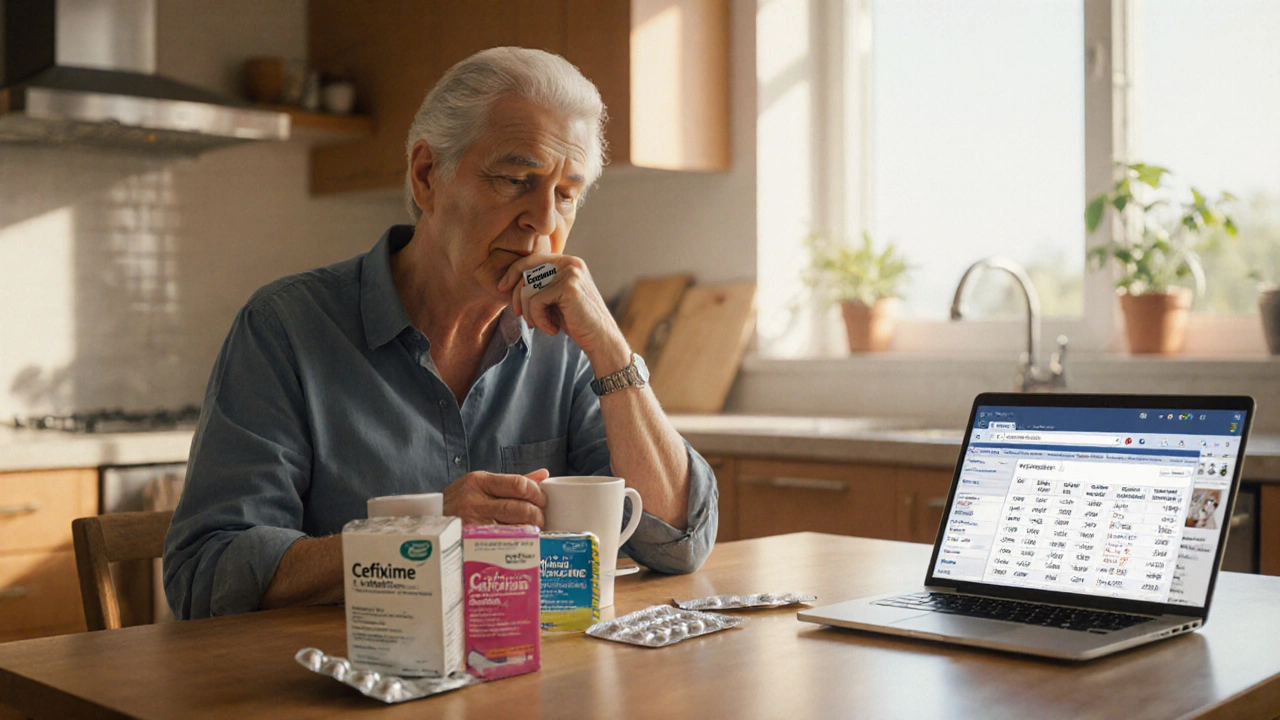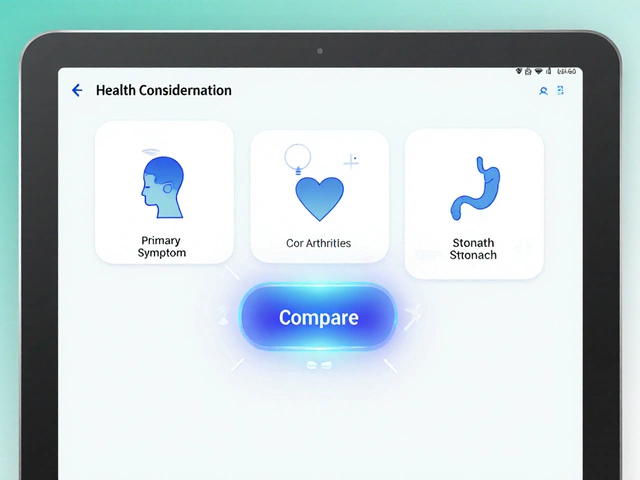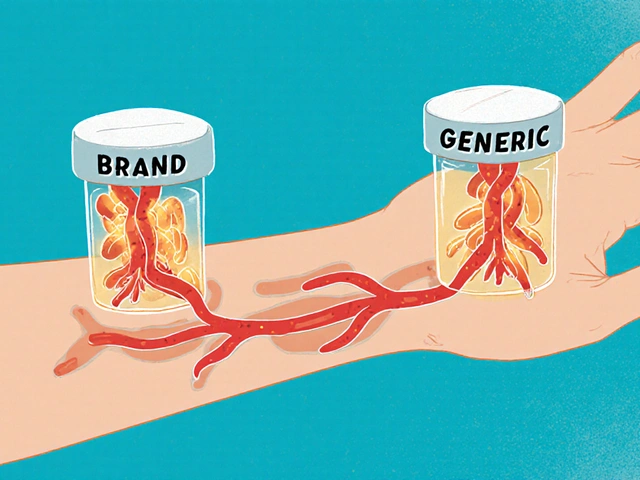Antibiotic Selection Advisor
Select the relevant parameters to get a recommendation on the best antibiotic for your case.
Recommended Antibiotic:
Reasoning:
Cefixime is a third‑generation oral cephalosporin antibiotic that works by inhibiting bacterial cell‑wall synthesis, making it effective against a range of Gram‑negative and some Gram‑positive organisms. Approved by the FDA in 1998, it is listed on the WHO Essential Medicines List and is sold in 100mg and 400mg tablets.
When a clinician prescribes an oral antibiotic, the decision hinges on the infection site, likely pathogen, resistance patterns, patient tolerance and cost. This article walks through the most common alternatives to Cefixime-Amoxicillin, Azithromycin, Ciprofloxacin, Doxycycline and Clarithromycin-so you can see where each one shines or falls short.
Key Attributes of the Central Antibiotics
- Amoxicillin is a beta‑lactam penicillin that targets a broad spectrum of Gram‑positive bacteria and some Gram‑negative strains. Typical adult dose: 500mg three times daily for 7‑10days.
- Azithromycin belongs to the macrolide class, inhibiting bacterial protein synthesis. Standard regimen: 500mg on day1, then 250mg daily for four more days.
- Ciprofloxacin is a fluoroquinolone that blocks DNA gyrase. Common dose for uncomplicated urinary tract infection: 250mg twice daily for three days.
- Doxycycline is a tetracycline analogue interfering with ribosomal function. Adult dosage for respiratory infections: 100mg twice daily for five days.
- Clarithromycin is another macrolide, often used when azithromycin resistance is suspected. Usual dose: 500mg twice daily for seven days.
How Cefixime Stacks Up: A Side‑by‑Side Table
| Attribute | Cefixime | Amoxicillin | Azithromycin | Ciprofloxacin | Doxycycline | Clarithromycin |
|---|---|---|---|---|---|---|
| Class | Cephalosporin (3rd gen) | Penicillin | Macrolide | Fluoroquinolone | Tetracycline | Macrolide |
| Typical Indications | UTI, PID, CAP, Gonorrhea | Otitis media, sinusitis, pneumonia | Chlamydia, bronchitis, skin infections | UTI, prostatitis, traveller’s diarrhea | Acne, Lyme disease, atypical pneumonia | Mycobacterium avium, severe CAP |
| Resistance Concerns | Increasing ESBL‑producing Enterobacteriaceae | Beta‑lactamase producing H. influenzae | Macrolide‑resistant S. pneumoniae | Fluoroquinolone‑resistant P. aeruginosa | Tet‑M mediated resistance | Macrolide‑resistant Mycobacteria |
| Side‑Effect Profile | Diarrhea (10‑15%), mild rash | Allergic rash, GI upset | GI upset, QT prolongation (rare) | Tendonitis, CNS effects | Photosensitivity, esophageal irritation | Hepatotoxicity, taste disturbance |
| Cost (UK, 2025) | £4.50 for 10 tablets (400mg) | £2.20 for 21 capsules (500mg) | £7.90 for 6 tablets (500mg) | £6.30 for 10 tablets (500mg) | £5.40 for 14 capsules (100mg) | £9.00 for 14 tablets (250mg) |
When Cefixime Is the Right Choice
If a patient presents with uncomplicated community‑acquired pneumonia (CAP) and local resistance data show Streptococcus pneumoniae still susceptible to third‑generation cephalosporins, Cefixime offers a convenient once‑daily regimen (400mg) with a low allergy risk compared to penicillins. It also penetrates well into genital secretions, making it a preferred oral option for uncomplicated gonorrhea in regions where azithromycin resistance has surged.
Scenarios Where Alternatives Shine
Consider a 28‑year‑old woman with a urinary tract infection caused by Escherichia coli that produces extended‑spectrum beta‑lactamases (ESBL). Cefixime’s activity drops dramatically, so guidelines recommend a fluoroquinolone such as Ciprofloxacin-provided local susceptibility is >90%-or a nitrofurantoin regimen.
For patients with a documented penicillin allergy, a macrolide like Azithromycin becomes attractive for atypical pneumonia caused by Mycoplasma pneumoniae. However, if the clinician is worried about QT‑interval prolongation (e.g., patient on anti‑arrhythmics), Doxycycline provides a safe alternative with comparable efficacy.

Pharmacokinetics at a Glance
Cefixime reaches peak plasma concentration in 2-4hours, has a bioavailability of ~50% and is eliminated largely unchanged in the urine (80%). Its half‑life of about 3‑4hours supports twice‑daily dosing for most infections. In contrast, Azithromycin’s long tissue half‑life (up to 68hours) permits a single‑day loading dose, while Ciprofloxacin’s high renal excretion (70%) necessitates dose adjustment in renal impairment. Understanding these differences helps avoid sub‑therapeutic levels or unnecessary toxicity.
Safety and Tolerability: What to Watch For
All oral antibiotics carry a risk of Clostridioides difficile infection, but the incidence with Cefixime is modest (≈1case per 10,000 courses). More common are mild gastrointestinal symptoms-nausea, loose stools-that resolve after therapy ends. If a patient experiences a rash, clinicians should assess for a true allergy versus a harmless drug‑related eruption before switching classes.
Fluoroquinolones such as Ciprofloxacin have the most alarming safety warnings, including tendon rupture and peripheral neuropathy. These concerns have led many guideline committees to demote Ciprofloxacin to a second‑line agent for uncomplicated infections, reserving it for cases where other options are contraindicated.
Cost‑Effectiveness and Access
In the UK’s National Health Service (NHS) formulary, Cefixime is priced competitively for a 10‑day course, especially when the infection requires a higher‑dose regimen (400mg twice daily). Azithromycin, while offering dosing convenience, costs roughly double per tablet, which can matter for patients paying out‑of‑pocket.
When budgeting for a community health clinic, administrators often run a simple cost-effectiveness model: Cost per cure = drug price / (clinical success rate × adherence factor). Because Cefixime’s twice‑daily schedule yields a higher adherence factor than three‑times‑daily Amoxicillin, its overall cost per cure can be comparable or even lower despite a higher per‑tablet price.
Putting It All Together: Decision Tree
Below is a quick mental checklist you can use during a prescription review:
- Identify the likely pathogen and local resistance data.
- Check patient allergies: penicillin‑allergic → avoid Amoxicillin; macrolide‑allergic → avoid Azithromycin/Clarithromycin.
- Assess infection site: urinary tract → consider Cefixime, Ciprofloxacin, Nitrofurantoin; respiratory → Azithromycin, Doxycycline, Clarithromycin.
- Evaluate safety: renal impairment → prefer non‑renally cleared agents; risk of tendon injury → avoid Ciprofloxacin.
- Factor cost and dosing convenience for the patient.
Following this flow usually lands you on the most appropriate oral agent, whether that’s Cefixime or one of its peers.
Related Concepts and Further Reading
Understanding Bacterial resistance mechanisms (beta‑lactamase production, efflux pumps, target‑site mutations) provides deeper insight into why an antibiotic may fail. Similarly, familiarity with the WHO Essential Medicines List helps clinicians choose drugs with proven global utility and supply stability.
For a more detailed pharmacologic breakdown, see the next article in this series on "Pharmacokinetics of Oral Cephalosporins".

Frequently Asked Questions
Can I use Cefixime for a stomach infection?
Cefixime is not the first‑line choice for most gastrointestinal infections because many common gut pathogens (e.g., Clostridioides difficile) are intrinsically resistant. Metronidazole or vancomycin are preferred for C.difficile, while a fluoroquinolone may be used for certain diarrheal illnesses if susceptibility testing supports it.
What is the usual adult dose of Cefixime for gonorrhea?
The recommended single‑dose regimen for uncomplicated gonorrhea is 400mg of Cefixime taken orally as a single dose, provided local Neisseria gonorrhoeae susceptibility is confirmed. Many health authorities now advise dual therapy with azithromycin to cover potential co‑infection with Chlamydia trachomatis.
Is Cefixime safe during pregnancy?
Cefixime is classified as pregnancy category B in the UK, meaning animal studies have not shown risk and there are no well‑controlled studies in pregnant women. It is generally considered safe when the benefits outweigh potential risks, especially for urinary infections where untreated disease poses a greater hazard.
How does resistance to Cefixime develop?
Resistance primarily arises from the acquisition of extended‑spectrum beta‑lactamases (ESBLs) and from mutations in penicillin‑binding proteins that reduce drug affinity. In some regions, plasmid‑mediated enzymes like CTX‑M have spread, making Cefixime ineffective against common Enterobacteriaceae.
When should I choose Azithromycin over Cefixime?
Azithromycin is preferred for atypical pathogens such as Mycoplasma pneumoniae or for sexually transmitted infections like chlamydia, where its long tissue half‑life allows a simplified dosing schedule. It also avoids the need for renal dosage adjustments, which can be advantageous in patients with severe kidney disease.
What are the most common side effects of Cefixime?
The majority of patients experience mild gastrointestinal upset-nausea, abdominal discomfort, or loose stools-in about 10‑15% of courses. A rash occurs in roughly 2‑3% and is usually self‑limiting. Severe allergic reactions are rare but require immediate medical attention.







Michael Barrett
September 27, 2025 AT 02:38 AMWhen one contemplates the selection of an oral antibiotic, the mind drifts toward the labyrinthine interplay of microbiology, pharmacokinetics, and socioeconomic factors.
Cefixime, a third‑generation cephalosporin, offers a spectrum that straddles the line between Gram‑negative adequacy and Gram‑positive modesty.
Yet, the very virtue of its broad coverage becomes a double‑edged sword in regions besieged by ESBL‑producing Enterobacteriaceae.
One must ask, does the convenience of a once‑daily dose outweigh the peril of fostering resistance?
In the grand tapestry of antimicrobial stewardship, dosage frequency is but a single thread.
Renal dysfunction, a silent specter, demands a recalibration of agents that are heavily excreted unchanged.
Cefixime, with approximately 80 % renal elimination, may thus be suboptimal for patients with creatinine clearance below 30 ml/min.
Conversely, azithromycin’s hepatic clearance renders it a safer harbor in such scenarios.
Cost considerations, often dismissed as peripheral, actually anchor prescribing habits in many health systems.
A ten‑tablet course of Cefixime priced at £4.50 can be perceived as extravagant when compared to a seven‑day course of amoxicillin at £2.20.
Nevertheless, adherence improves when dosing intervals shrink, a factor that may offset the marginal price differential.
The pharmacodynamic target of %T>MIC for beta‑lactams further underscores the necessity of maintaining adequate plasma concentrations.
If the pathogen’s MIC hovers near the breakpoint, a split‑dose regimen of Cefixime could salvage therapeutic success.
Clinical guidelines, however, caution against such maneuvers without susceptibility data.
Thus, the clinician stands at a crossroads, weighing microbiological data, patient comorbidities, and economic realities before committing to Cefixime or an alternative.
Inma Sims
September 27, 2025 AT 06:32 AMOne cannot help but marvel at the sheer ingenuity of medical literature that presents an exhaustive table comparing Cefixime to Amoxicillin, Azithromycin, and their ilk, as if the average patient were expected to parse pharmacokinetic parameters over breakfast.
Nevertheless, the author has done a commendable job of laying out the data, albeit in a manner that would undoubtedly delight a spreadsheet enthusiast.
It is truly heart‑warming to see cost per cure dissected with such zeal; one can almost hear the faint echo of corporate finance meetings in the background.
Gavin Potenza
September 27, 2025 AT 10:25 AMAlright folks, let’s cut to the chase-Cefixime is decent, but don’t forget the whole ESBL thing.
In my practice I’ve seen it work for uncomplicated UTIs, yet I’ve also watched it flop when resistance rates sky‑rocket.
So, keep an eye on local antibiograms before you write that script.
Virat Mishra
September 27, 2025 AT 14:18 PMIf you think waiting for a cure is romantic then by all means keep using it
Daisy Aguirre
September 27, 2025 AT 18:12 PMGreat breakdown! Your deep dive really illuminates the hidden trade‑offs that most clinicians skim over.
It’s refreshing to see the cost versus adherence discussion framed in such a practical way, especially for community clinics where every pound counts.
Keeping an eye on renal function while balancing dosing frequency is exactly the kind of nuance that prevents both under‑treatment and unnecessary toxicity.
Thank you for turning a dense topic into something actionable for the front‑line prescriber.
Tiffany Clarke
September 27, 2025 AT 22:05 PMCefixime works sometimes
Sandy Gold
September 28, 2025 AT 01:58 AMHonestly, the article seems to think "Cefixime" is some kind of panacea, which is simply not the case.
Definately, you need to look at the local resistance patterns – you can’t just blithely prescribe a cephalosporin and hope for the best.
The whole "once‑daily dosing" hype ignores that many patients are actually non‑adherent even with a single dose, especially if they experience GI upset – teh desertion rate is higher than you think.
Also, the cost comparison seems cherry‑picked; it doesn’t factor in the hidden costs of treatment failure.
Frank Pennetti
September 28, 2025 AT 05:52 AMFrom a pharmacoeconomic standpoint, the utility of Cefixime is contingent upon the incremental cost‑effectiveness ratio (ICER) relative to the willingness‑to‑pay threshold, which varies across health systems.
Furthermore, the emergence of extended‑spectrum beta‑lactamases (ESBL) alters the drug’s net present value in the antimicrobial arsenal, necessitating a dynamic stewardship model.
In high‑ESBL prevalence settings, the probability of therapeutic success drops below 70 %, rendering Ciprofloxacin or nitrofurantoin more cost‑effective despite higher unit prices.
Adam Baxter
September 28, 2025 AT 09:45 AMHey, don’t let the jargon scare you! Let’s break it down: if the local ESBL rate is low, Cefixime’s cheap price and simple dosing win.
If the resistance is high, switch to a drug with proven activity – the math works out in the long run.
Bottom line: know your local data and pick the smartest option for your patients.
Keri Henderson
September 28, 2025 AT 13:38 PMRemember, the key is aligning drug choice with patient values, clinical evidence, and local resistance trends.
When you involve the patient in the decision‑making process, adherence improves, and side‑effect concerns are addressed up front.
elvin casimir
September 28, 2025 AT 17:32 PMActually, you should note that your sentence "aligning drug choice" lacks a serial comma, which can lead to ambiguity.
Also, the phrase "clinical evidence" should be pluralized when referring to multiple studies.
Precision in language mirrors precision in prescribing – a small detail, but it matters.
Steve Batancs
September 28, 2025 AT 21:25 PMWhile acknowledging the diverse perspectives presented, it is imperative to integrate evidence‑based guidelines with real‑world constraints to optimize therapeutic outcomes.
Ragha Vema
September 29, 2025 AT 01:18 AMSure, but have you considered that the pharma lobby might be pulling strings behind the scenes, nudging clinicians toward higher‑margin drugs like Cefixime?
Sometimes the “guidelines” are more about profit than patient benefit.
Scott Mcquain
September 29, 2025 AT 05:12 AMIt is morally indefensible to prescribe broad‑spectrum antibiotics without rigorous stewardship; the very act contributes to a looming public health crisis.